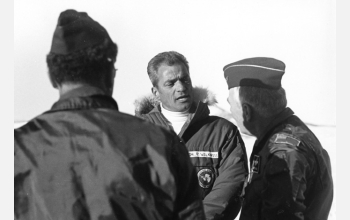News Release 05-101
Polar Science Leader Peter Wilkniss Passes
Statement by Karl A. Erb, director of the Office of Polar Programs

Peter Wilkniss (center) greets crew members of a C-5 transport plane near McMurdo.
June 21, 2005
This material is available primarily for archival purposes. Telephone numbers or other contact information may be out of date; please see current contact information at media contacts.
On behalf of the Office of Polar Programs, I wish to express deep regrets at the passing of Peter E. Wilkniss, who set the agenda for polar science at the National Science Foundation (NSF) during the late 1980's and early 1990's and whose legacy of leadership continues today.
Dr. Wilkniss died earlier this month at the age of 70 at his home in Anchorage, Alaska.
While at NSF, he served as director of the Division of Polar Programs (DPP) when it was part of the Directorate for Geosciences. He continued to direct the activities of the Office of Polar Programs when it was relocated to the office of the NSF director.
He made numerous contributions to the advancement of polar science.
During his tenure, construction began to consolidate laboratory spaces at McMurdo Station into a single building, which is known as the Albert P. Crary Science and Engineering Center. Wilkniss received the American Institute of Architects' Presidential Citation in 1993 for his work.
He was a prime mover in the late 1980's to establish the Council of Managers of National Antarctic Programs (COMNAP), an international consultative body.
Wilkniss was also DPP director during the National Ozone Expeditions in the 1980's, which were instrumental in determining the causes of the so-called Ozone Hole in the Southern Hemisphere.
He oversaw the completion of the ice-breaking research vessel, Nathaniel B. Palmer, which continues to conduct science operations in the Southern Ocean.
Wilkniss was a key player in establishing NSF's Arctic research programs and was also influential in encouraging greater participation by women in polar science.
Wilkniss joined NSF in 1975. He served as deputy assistant director for the Director for Scientific, Technological, and International Affairs. He also served on the staff of what was then the Directorate for Astronomical, Atmospheric, Earth, and Ocean Sciences; as program officer for the National Center for Atmospheric Research; a program manager for the Ocean Sediment Coring program; and as division director for Ocean Drilling Programs. Wilkniss served as the senior science associate to a previous NSF director and was designated a "Distinguished Executive" by President Ronald Reagan in 1987.
Prior to joining the Foundation, Wilkniss was head of the Chemical Oceanography Branch of the Naval Research Laboratory's Ocean Sciences Division in Washington, D.C.
After leaving NSF in the late 1990's, he moved to Alaska, where he founded the Transnational Arctic and Antarctic Institute, which, among other projects, supported the computer-assisted translation of Alaska Native languages to preserve the languages themselves and to improve communication among various native language speakers and between them and English speakers.
The community of polar researchers is small. Even smaller is that group of people who have left a lasting mark on polar science. Both of those groups are sadly diminished by Peter Wilkniss' death.
Daily, we in OPP both benefit from and celebrate his legacy as one of the community's leading lights.
We offer our condolences to his loved ones.
-NSF-
Media Contacts
Dena Headlee, NSF, 703-292-7739, email: dheadlee@nsf.gov
The U.S. National Science Foundation propels the nation forward by advancing fundamental research in all fields of science and engineering. NSF supports research and people by providing facilities, instruments and funding to support their ingenuity and sustain the U.S. as a global leader in research and innovation. With a fiscal year 2023 budget of $9.5 billion, NSF funds reach all 50 states through grants to nearly 2,000 colleges, universities and institutions. Each year, NSF receives more than 40,000 competitive proposals and makes about 11,000 new awards. Those awards include support for cooperative research with industry, Arctic and Antarctic research and operations, and U.S. participation in international scientific efforts.
Connect with us online
NSF website: nsf.gov
NSF News: nsf.gov/news
For News Media: nsf.gov/news/newsroom
Statistics: nsf.gov/statistics/
Awards database: nsf.gov/awardsearch/
Follow us on social
Twitter: twitter.com/NSF
Facebook: facebook.com/US.NSF
Instagram: instagram.com/nsfgov


